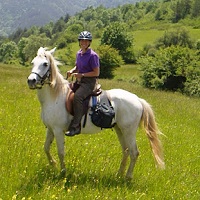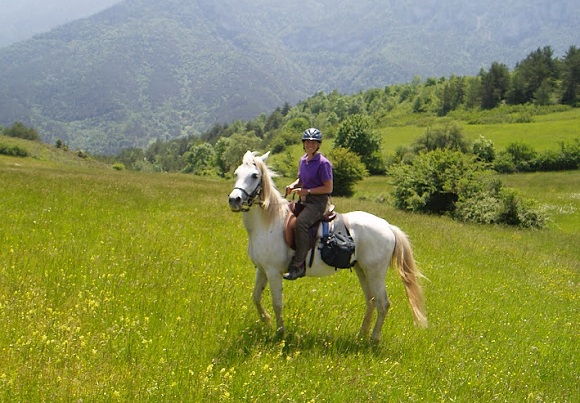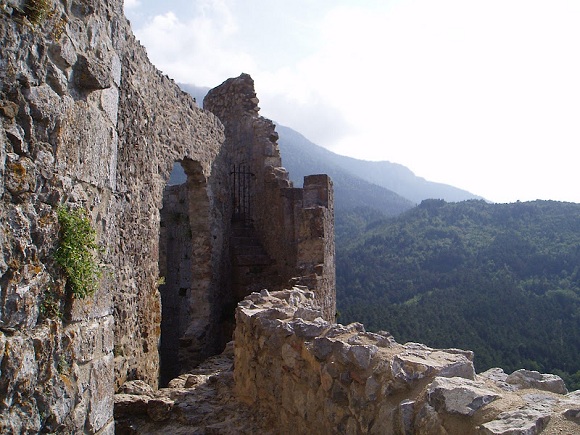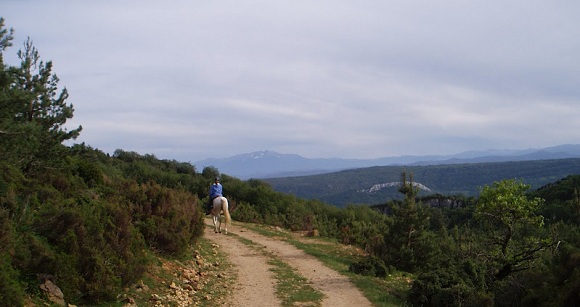
Horseback riding in southwest France with a stunning view of the Pyrenees over their shoulders was a dream come true for Judy and Dave Kashoff… until they mistakenly left the trail and Judy’s white Arabian horse sank into a bog. Judy tells the horrifying tale of a dream ride that turned into a nightmare.
* * *
The horizon shot upwards as my horse and I sank into the ground. Suddenly, I was seeing the trees and sky of southern France from a different perspective. Like an elevator that had suddenly broken free of its cable, I had taken a quick trip down. Although still mounted, my feet were resting on the earth–and under the earth–muddy, swampy earth. My horse, Iadj, a plucky, pure white Arabian horse, in one easy, carefree step, had sunk up to his lovely shoulder into a bog.
“Get off, get off!” I heard my husband shout.
Stunned, I had remained frozen in place. I leaped off, pulling the reins over the horse’s head.
Now on solid ground, I could see my mount was half buried. I tried to clear the way in front of him with my hands, but I was only swirling around a thick, slimy stew. Not liquid enough to swim in, and too deep for the horse to touch bottom.
Iadj, the white Arabian, heaved forward, rising up a little.

“Yes,” I thought, he’ll grab solid ground!” But his effort just took him forward–farther from shore and even deeper. Fear gripped me–now his hind quarters were solidly entrenched. This reservoir was not a pond to quench my horse’s thirst; it appeared, rather, that it was to be his grave.
Dave and I were riding alone in a remote area in the huge stretch of parkland in the Languedoc-Rousillon region of France. Earlier in the day and yesterday we had exchanged greetings with people hiking the same trails we followed, often an older couple, usually French but sometimes English or German. They carried walking sticks and wore zip-off khakis. But today we hadn’t seen another person for hours. Up until the moment Iadj lifted his hoof off a solid bank to place it into a daylit nightmare, this solitude had been part of the pleasure of our explorations in the region.
Charly and Nicole from the Ferme Equestre, where we’d rented our horses for the week, had provided us with two well-mannered and willing mounts, a series of maps, and reservations at an assortment of inns, farms, and lodges. This was our third day of leaning forward over our horses’ withers as they carried us to mountain-top vistas and down again on steep rocky tracks. We hiked alongside our steeds when the trail was too difficult. Dark narrow paths through woodland opened up into sunny fields of cerulean flowers where we dismounted to open and then close behind us pasture gates. Footpaths along clear quiet streams led us to 17th-century mountainside villages where church bells rang over the steady beat of our horse’s hooves. On this day we had looked forward to tying our horses in the courtyard of the ruins of the 10th-century Castle of Puylaurens, where they would rest while we walked under still-standing stone archways to view the valley below through ancient windows built into a wall fused to a cliff.
Our biggest problem to date had been getting lost for almost two hours on our first day out. Being lost was something we’d done quite a bit the year before, when we took this trip for the first time. And although the trail was to deviate a bit this year, it hadn’t yet, and we had no real excuse for losing our way. Instead of concentrating on the trail, our attention was on the countryside, where cows grazed contentedly in clover covered pastures and dogs looked after recalcitrant sheep on steep hillsides. The forest pathways were green and cool, but also a bit confusing: getting lost then finding our way took time. We neglected to anticipate the concern yesterday evening’s host and hostess would have for us as sunset approached. Worried, they had called Charly, who then became worried himself because of course, we should not be lost—he knew we’d been here before and must know our way.

We should have known our way today also, but a small stream, not much more than a trickle, crossed the path ahead and Dave and I differed in our recollections. He did not remember crossing water here, so we pulled off the trail to discuss it. There was a sign that was perfect for tying the horse’s reins while we examined our map. The sign was next to a small pond. My horse, unbeknownst me, was expecting a drink, because he knew very well where the path went: it did cross the stream and that brook was one of the places the horses quenched their thirst while carrying tourists like ourselves over the mountain trail. So while Dave was tying his horse to the wooden sign, my horse was eyeing the pond. I dropped the reins on his neck and allowed him to mosey over for a drink. He lowered his head and took a few steps forward. One step too many took us right off the solid edge of land and into the mire. “Baignade Interdite” is what the sign said: NO SWIMMING”.
Now Charly would really have something to worry about. Calling his wife was the only sensible call we could make. Nicole spoke English fairly well, and she could call some kind of emergency crew. Would we have cell phone signal on this mountain top, will Nicole be home, and would she understand the English word for “bog”? I tried to remember the French word for “mud.” My mind raced as the horse thrashed in the muck. What should I do? What if Nicole doesn’t answer. Should I call someone else? Who? Years ago I’d seen on television a horse stuck in a bog. They pulled it out with an enormous crane. Would someone have a crane? Neither one of us knew the French equivalent of 911*.
I doubted if there was a road or village nearby, but if I reached someone, what would we say? “Vin rouge, s’il vous plaît?” My French is basic. How could I express this situation? “Uh, excuse me, but my horse is at this very moment drowning in a bog—can you send a winch or something?—Well, actually, no, I don’t have any idea where I am….lots trees, and oh, yeah—muddy water.” How does one say “drowning” in French? I wished desperately for someone to come by. Where were the trekkers? It seemed clear that this lovely Arabian horse, mine for a week, was in great danger.
My hand reached for the cell phone as Iadj surged forward again. I could see the horse gather his strength. He rose above the mire, moving forward several feet, but when he landed he was on his side, almost his back—his legs kicking in the air. He twisted and then he was back in the original vertical position. His hindquarters didn’t look right—it appeared as if his legs were twisted beneath the muck. All that struggling made me fear a broken leg. One hip looked bad, pushed up. I could only hope this leg was safe, but resting on higher ground, while the rest of him was deeper into the muck.
He now stayed still for what seemed a very long time, his head and neck stretched along the top of the surface. I’d never seen a horse in such an awkward position. His body was so deep in the ground that his chin was cradled by the earth. Was he resting again, or had he given up? Each advance had taken a great deal of energy. He was closer to the far shore now. Perhaps he could make it. Only six years old, he was very fit from traveling five or six hours a day on steep, challenging terrain. But this was taking a great deal out of him; he appeared spent.
His next effort took him closer to the far edge of the pool. And the leg that had seemed strangely poised must have been well positioned, not broken, giving him something to push off with. Now when he lurched forward again he almost reached the shore.
He rested again. If he could raise himself enough, he could touch the edge. But the side here was steep. I had the reins; I had to do something. I could guide him to the best spot. He was very close to the steep, rocky side. I had never seen a horse scramble up something so vertical. If I guided him to the left a bit, it seemed to be a more gradual climb. But was the ground firm or more swamp?
I guided him hesitantly towards the more gradual climb and he followed, but he, too, was uncertain. One forefoot reached forward, only to drop down into the morass. It would have to be the steep side.

Neither Dave nor I could imagine how much longer he could struggle before exhaustion took over, or his heart gave out. I moved the reins to the right, and I don’t know whether he took my cue or just saw for himself he wasn’t going to make it the other way, but he changed his course in mid-leap.
Suddenly, his front feet were touching the solid ground of the bank. Scrambling, a hind leg gained purchase. He was almost vertical now, his legs moving furiously; climbing, sliding—a leg would land, only to slip after dislodging a rock. For a few moments he seemed to be scrambling in the air and it didn’t seem possible he’d reach the top. I thought he would slide back into the quagmire, maybe this time forever. But providence was with me and this horse because suddenly he seemed to gain a strong foothold.
“He’s OK!” my husband shouted.
I wasn’t so certain. This horse had been thrashing about—he seemed twisted beneath the surface. I feared the vision of him rising from the soup of the bog with a dangling leg, broken, the end for this lovely horse who tried so hard, bursting out of one deadly dilemma only to meet another.
He stood. He took a step. He shook himself and mud flew everywhere, but he seemed to be alright.
Happy to be slapped with showering sludge, relief washed over me like a river. And it was going to take a fairly deep river to clean this horse. This pretty white horse was now completely brown. The small patch of white on the side of his head and neck that hadn’t been enveloped in the bog were now splashed with muck from when he had shaken his body.
I threw off his saddle and saddlebags—everything was coated with a thick layer of gritty loam. He shook again and the white patch where his saddle had been became less white. My clothing was splattered, my shoes squishy.
Now that Iadj was safe, I had a new goal—get him cleaned up before anyone saw him. This was cowardly and dishonest of me, and I must admit my husband did not agree with my duplicity, but the moment relief washed away fear a new emotion sprang forth in my breast: embarrassment.
I didn’t want to have to explain how I almost killed this horse to the people who were already puzzled about why we had gotten lost on a route we’d traveled before. They had provided us with maps and detailed instructions written in both French and English and numbers we could call on our cell phone. In addition, hopefully unbeknownst to them, we had a handheld GPS which we couldn’t figure out how to use. And now we had nearly drowned their horse right next to a “No Swimming” sign. I was mortified by my ineptitude, my adrenaline was still high. I now had a new mission: deceit.
I fashioned a halter from a lead rope and washed the bridle in the creek, the same creek that we were meant to cross and that Iadj was meant to drink from. I took off my grimy tell-tale shirt and replaced it with one in my saddle bag that had remained reasonably protected. I used the soiled shirt to carry water between the creek and the horse who rested quietly while my husband held him.

It took an hour and a half to get him close to clean. As brown rivulets flowed off, several bloody spots appeared on his legs. All minor cuts and scrapes—probably caused by his own flailing hooves during his struggle.
While I cleaned, other people finally appeared: it was an older couple wearing zip-off trousers. They raised their walking sticks in our direction. “Bonjour!” they called out in a German accent. “Bonjour!” I replied with bravado.
Clean and rested, we set off, and Iadj seemed happy to be traveling on solid ground again. I experienced my final bit of relief as we moved off into a steady trot, with none of the head bobbing that would indicate a limp and therefore an injury. We rode through thickly wooded trails until we reached a clearing from where we looked down upon the red roof tops of a town in the valley and then rode through an old stone village, grey except for the brilliant blue shutters framing each window.
In our desire to arrive on schedule to our evening’s abode and keep our adventure a secret, we made up lost time by skipping our last route direction; the climb to the castle. We took the road below, and the silhouette of Puylaurens, high on the hill above us, shadowed our path for a long while. We watched the sun descend behind its maze of old stone walls. The magic of an early evening in a beautiful place pulled us back to the pleasures of our vacation. My horse walked with a spring in his step and his white coat shone against the dark of the mountains beyond.
© 2012, Judy Kashoff.
Judy and Dave Kashoff have been traveling extensively around the world since 2008. Rather than wait for the proverbial golden years, they rented out their house in a suburb of Philadelphia, dropped their cats off with Dave’s mother, kissed their two grown children good-bye, and set off for what they thought would be a year of travels by boat, by bike, by horse, by foot, by kayak and by golly let’s just do it! Four years on they are still at it.
*Editor’s note: 911 actually does work from mobile phones in France. It’s immediately transferred to the European emergency number 112. The more common numbers in France, however, are 17 for the police and 18 for the fire department and for other accidents and emergencies such as the one told here.


Judy–Just opened for a peek and saw you astride a horse with a good story to tell. What a way to see France up close and personal!